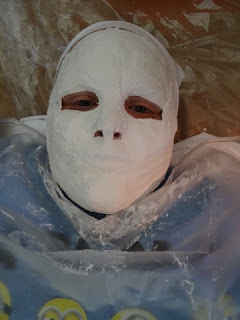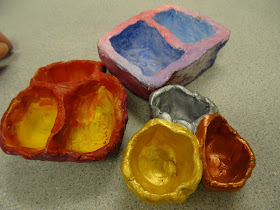Let me say it up-front. Clay's not really my thing; when it comes to building in three-dimensions, I'm more of a papier-mache / plaster bandage sorta gal. My clay experience is limited; I took one class in college, while home for the summer, and then for the next 8 years I taught high school photography, drawing, and painting Somebody else taught the clay classes.
(Above, slab big-mouth fish, and below, slab faces; both are in Marblex air dry clay.)
Home to me was Saratoga Springs, where Skidmore college is located. They had a very respected ceramic artist teaching the class, and I was out of my element. I was used to a state university budget and life and suddenly I was at an exclusive private school. I went to work as a waitress in the evenings, and in class was surrounded by spoiled rich kids who ignored this little hippy-dippy 'townie'. I never fell in love with clay. However, I did enjoy the potter's wheel, (though I couldn't raise a decent pot any higher than my hooked-together thumbs). I have a memory of my waist-length pony tail spinning around the wheel in the clay, and of my mother's horrified look and her demands for me to remove my shoes immediately and get in the shower when I walked in the door after class.
(Below, pinch pot turtle pot in air dry Mexican Pottery clay.)
Nevertheless, when I began teaching elementary art, I felt it was important for kids to have at least one clay experience every year. My classroom did not have a kiln, so I learned to use air-dry clay successfully by trial and error, and in this post I want to share what worked, in case you are also in a kiln-less art room. I located all the pieces pictured here a couple of weeks ago, when I was subbing in my former classroom. They are all samples made by me, using air dry clay.
First, the clay. I am NOT a fan of creepy Model Magic, though I know some of you love it, and use it in interesting ways. For me, it does not mimic the texture and feel of clay, and lacks the solidity of a genuine clay piece. I have experimented with several types of air dry clay, and pretty much settled in with Amaco's Marblex (a very paintable pale gray color) and Mexican Pottery Clay (a nice red-brown color). The photos in this post are of clay pieces made with these two air dry clays. I tried less expensive "store brands" and found they did not hold together well at all. I tried more expensive brands and liked them, but they weren't affordable for what I wanted to do. I'm struggling to recall the name of one excellent quality clay that dried rock hard and bright white. Very durable, in comparison, but also very pricey.... Also, several years ago I received a sample of some dark reddish brown air dry clay with a lot of grog in it, that dried rock hard, and after sampling it, I really loved the texture and consistency and quality. But I was never able to find it in a catalog, so I've long forgotten the brand name.
(Below, pinch and pull gator, Marblex; and unpainted dragon, unknown brand hard white air dry clay)
Air dry clay is always going to be more breakable than kiln-fired clay. The best way to use air dry clay with minimal breakage is by having no thin appendages, and by making pieces in just one session. You can use slab construction, coil construction, and of course pinch pots, as well as pieces made by pinching and pushing, such as the gator, above. And you can mix the clay with water to make slip. So basically, it still can very much mimic the sensation of working with 'real' clay.
In order to get a clay project complete in one art class, a good idea is to use the prior art class for "clay play", to familiarize the students with the materials and the techniques, and also to demonstrate what they will be doing in their next art class. That way, in the next class, all you need is a quick review and away you go! I always had blocks of clay measured out and ready for the kids, so they could get right to work. The "
posy pockets" pictured below are an example of an air dry project that was successful. I often did this with my 2nd graders.
To make these, students rolled out a rectangular slab, trimming off any excess. They scored close to the long edges, put slip on the scored edges, and then folded the pocket, leaving about a third or quarter of the rectangle above the fold, and keeping a couple of fingers inside when they folded. Then, the top was trimmed to an arc or peaked shape, and any remaining clay after trimming was used to make embellishments, which were attached by scoring and putting on slip. I had the kids put two fingers in the pocket and gently wiggle the decoration into place, as though they were playing with a peanut butter and jelly sandwich and wanted to get the jelly to squirt out the sides. This way, the embellishment would stick better. We also used tools to add texture, and cut a hole in the top for hanging over a nail.

The posy pockets (and pretty much all air dry clay projects) were painted with acrylic paints; I used Nasco's Bulk-krylic. The kids were cautioned NOT to use air dry clay for food or liquids; it is not permant. So we made tiny tissue paper bouquets of posies, with pipe cleaner stems, to put in the pockets.
The
fish above are a slab project similar to the posy pockets but
requiring a bit more sophistication. Instead of putting our fingers
inside, we stuffed the mouths with paper towels. Again, excess clay was
used for embellishment.
The
fish below were a ridiculously easy slab project. Again, a slab was
rolled out. I demonstrated how to cut the slab to make tail and fins
and mouth, and again extra clay could be used for embellishment. The
fish body was curved to stand up.
We made
clay people using a similar process, starting with a rectangle, cutting away squares from the both sides of the top to leave a head, and vertical rectangles from both sides of the bottom. Then slits were made straight up from the corner of where the rectangle was cut, to create arms, and a slit was cut in the bottom to create legs. The bodies could then be molded and posed by bending and pinching the clay. We used this process because air-dry clay is much more breakable, and if slip and score techniques are not used well, add-ons will fall off. So working with a one piece pull and pinch construction with younger kids was very successful.
We made a lot of
crawly critters this way - lizards and dragons and alligators and turtles and such, as well as animals lying down, like cats and dogs. This way, we avoided the narrow appendages snapping off. Still, sometimes they will break. Glue generally does NOT hold air dry clay. The best solution I have every found is using the acrylic paint to repair breakage. So, when the tail of the critter below broke off, I fixed it by filling the gap with green acrylic paint. In worst case scenarios, we'd joke about the art room being a hospital for injured animals, and "Dr. Brown" (me) would fix them, and add a little band-aid for extra security!
My fourth graders usually made
coil pots, using the Mexican Pottery Clay. Their work was much larger than my quickie samples below. We used scoring and slip and the peanut butter and jelly wiggle again! Snails could be made and worked into the pot as desired, by placing a coil up and over them to secure them. I had the kids frequently hold them up to the light to check for gaps, and then wiggle the gaps closed. I gave each child a hunk of clay to start, they rolled the base, and then started adding coils. If they ran out of clay, they could come for another hunk until we ran out of time. Some students made small pieces with fine coils, others made big wide or tall pots. My samples are small because all I did was a quick demo of coil technique.

Again, we painted with acrylic, and used it to fill any gaps. Acrylic paint makes the piece stronger. By the way, the kids could choose to leave the clay color exposed, but then would use an acrylic gloss such as Mod Podge to paint over it. For tall narrow pots, we poured in the gloss or paint, tilted it around to cover the inside, and then drained out the excess paint.
And of course, we made
pinch pots. (But no, I never made a single pinch pot owl. Sorry...) These "pinch pot clusters" pictured below were a favorite of my first graders, to take home and store their tiny treasures. They made three little pinch pots, scored and used slip to hook them together, and smoothed over the joints.
And we sometimes made cave paintings on random shaped clay slabs.
Finally, a quickie easy project, that was always a lot of fun.
Sneaker imprint jewelry! The kids loved pushing clay gently into the bottom of a neighbor's shoe, and then cutting them in interesting shapes. After these were dry and painted, we strung them with yarn and beads and more.
Late edits to this post - four points to make:
First - There is NO REASON to wedge air dry clay, since you won't be firing it and don't have to worry about it bursting. Actually, it is counterproductive, as it dries it out.
And second, try to finish everything in ONE SESSION. Keeping air dry clay properly moist and to a workable consistency once it's been out in the air is very difficult. Just get it done, and move on... You'll have trouble trying to continue working successfully on an air-dry piece after one sitting.
And the tools - you can use inexpensive plastic modeling tools, for scoring and texturing, as well as little pointed wooden sticks, and also, of course, slip made from the clay.
And finally, getting them home safely - I would ask students to bring in cube-style tissue boxes, which were great for bringing home coil pots, for example. We padded them in newspaper or other stuffing material before gently putting in the box for safe travels. I always warned kids against putting clay projects in the bottom of their backpacks, where they'd throw lunchboxes and sneakers on top. For the little pinch pots and other small delicate pieces, if I had nothing to pack them in safely, I told the kids to carry them in their hands like they were baby birds, who hadn't yet leaned to fly. If they fell out of the 'nest', they probably would be injured. I loved seeing them walk to the school buses, cradling their 'baby birds' in their hands!

































































